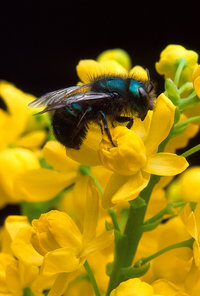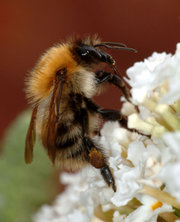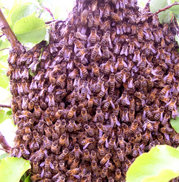They are adapted for feeding on nectar and pollen, the former primarily as an energy source, and the latter primarily for protein and other nutrients. Most pollen is used for food for the brood.
Bees have a long proboscis that enables them to obtain the nectar from flowers. Bees have antennae made up of thirteen segments in males and twelve in females. They have two pairs of wings, the back pair being the smaller of the two.
Bees play an important role in pollinating flowering plants, and are called pollinators. Bees may focus on gathering nectar or on gathering pollen, depending on their greater need at the time. Bees gathering nectar may accomplish pollination, but bees that are deliberately gathering pollen are more efficient pollinators. It is estimated that one third of the human food supply depends on insect pollination, most of this accomplished by bees.
Bees are fuzzy and carry an electrostatic charge, thus aiding in the adherence of pollen. Bees periodically stop foraging and groom themselves to pack the pollen into specialized pollen baskets which are on the legs of honeybees and some other species, and on the ventral abdomen on other species.
Bees are extremely important as pollinators in agriculture, with contract pollination having overtaken the role of honey production for beekeepers in many countries. Monoculture and pollinator decline have increasingly caused honeybee keepers to become migratory so that bees can be concentrated in areas of pollination need at the appropriate season. Many other species of bees are increasingly cultured and used to meet agricultural pollination need. Bees also play a major, though not always understood, role in providing food for birds and wildlife. Many of these bees survive in refuge in wild areas away from agricultural spraying, only to be poisoned in massive spray programs for mosquitoes, gypsy moths, or other pest insects.
There are over 16,000 described species, and possibly around 30,000 species in total. Many species are poorly known. The smallest bee is a dwarf bee (trigona minima) and it is 1/12 in long. The largest bee in the world is the Megachile pluto.
Eusocial and quasisocial bees
Bees may be solitary, or may live in various sorts of communities. The most advanced of these are eusocial colonies, found among the honeybees and stingless bees. Sociality is believed to have evolved separately in different groups of bees.
Eusocial bees live in colonies, each of which has a single queen, together with workers and drones. When humans provide a home for a colony, the structure is called a hive. A hive can typically contain up to about 40,000 individual bees at their annual peak, which occurs in the spring, but usually have fewer.
Visiting flowers is a dangerous occupation, with very high mortality rates. Many assassin bugs and crab spiders hide in flowers to capture unwary bees. Others are lost to birds in flight. Insecticides used on blooming plants can kill large numbers of bees, both by direct poisoning and by contaminating their food supply. A honeybee queen may lay 2000 eggs per day during spring buildup, but she also must lay 1000 to 1500 eggs per day during the foraging season, simply to replace daily casualties.
Bumblebees (Bombus terrestris, B. pratorum, et al.) are referred to as quasisocial because the queen bee is typically able to survive on her own for at least a short time (unlike queens in eusocial species who must be cared for at all times). Bumblebee colonies typically have from 50 to 200 individual bees at peak population, which occurs in mid to late summer.
The population value of bees depends partly on the individual efficiency of the bees, but also on the population. Thus, while bumblebees have been found to be about ten times more efficient pollinators on cucurbits, the total efficiency of a colony of honeybees is much greater, due to greater numbers. Likewise, during early spring orchard blossoms, bumblebee populations are limited to only a few queens, thus they are not significant pollinators of early fruit.
The life cycle of bumblebees begins in the spring when the queen bee rises from hibernation. At this time the queen bee is the one who does all the work as there are no worker bees to do the work yet. She searches for a place to build her nest and she builds the honeypots. She also does the foraging to collect nectar and pollen. Bumblebee colonies die off in the autumn, after raising a last generation of queens, which survive individually. Interestingly bumblebee queens sometimes seek winter safety in honeybee hives, where they are sometimes found dead in the spring by beekeepers, presumably stung to death by the honeybees. It is not known whether any succeed in winter survival in such an environment.
With honeybees, which survive winter as a colony, the queen begins egg laying in mid to late winter, to prepare for spring. This is most likely triggered by longer day length. She is the only fertile female, and deposits all the eggs from which the other bees are produced. Except a brief mating period, when she may make several flights to mate with drones or if she leaves in later life with a swarm to establish a new colony, the queen rarely leaves the hive after the larvae have become full grown bees. The queen deposits each egg in a cell prepared by the worker bees. The egg hatches into a small larva which is fed by nurse bees (worker bees who maintain the interior of the colony). After about a week (depending on species), the larva is sealed up in its cell by the nurse bees and begins the pupal stage. After another week (again, depending on species), it will emerge an adult bee.
The larvae and pupae in a frame of honeycomb are referred to as frames of brood and are often sold (with adhering bees) by beekeepers to other beekeepers to start new beehives.
Both workers and queens are fed royal jelly during the first three days of the larval stage. Then workers are switched to a diet of pollen and nectar or diluted honey, while those intended for queens will continue to receive royal jelly. This causes the larva to develop to the pupa stage more quickly, while being also larger and fully developed sexually. Queen breeders consider good nutrition during the larval stage to be of critical importance to the quality of the queens raised, good genetics and sufficient number of matings also being factors. During the larval and pupal stages, various parasites can attack the pupa/larva and destroy or damage it.
Read more at Wikipedia.org




